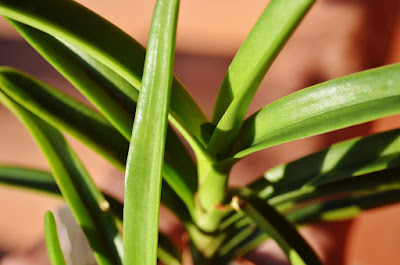Aerides krabiensis orchid, also called as The Krabi Aerides (Krabi is a town in Southern Thailand), is a species of the genus Aerides. This species was first described by Seidenf. in 1972. This species is native to the penninsular Malaysia (Langkawi Islands) and penninsular Thailand (Krabi) on vertical limestone cliffs at 150 - 400 m form sea-level.
Aerides krabiensis orchid, also called as The Krabi Aerides (Krabi is a town in Southern Thailand), is a species of the genus Aerides. This species was first described by Seidenf. in 1972.
IDENTIFY AERIDES KRABIENSIS ORCHID
This species is native to the penninsular Malaysia (Langkawi Islands) and penninsular Thailand (Krabi) on vertical limestone cliffs at 150 - 400 m form sea-level.
It is a small sized, hot to warm growing lithophyte with a monopodial stem carrying several thick, conduplicate leaves, variable in thickness. Flowering is carried out by arched axillary, arcuate, 4 3/4" to 5 1/2" (12 to 14 cm) long (sometimes longer), with several to many (12 to 15) flowered, mostly racemose inflorescence carrying simultaneously opening flowers, with pinkish white petals and sepals and pink trilobate labellum , with yellowish hull. Plant blooms in the spring.
GROW AND CARE AERIDES KRABIENSIS ORCHID
Usually the Aerides are very large and grow as hung as the vanda, however, The Aerides Krabiensis is small. It grows on cliffs in full sun, with intermediate-hot temperatures. The minimum that can stand is 11, the maximum is also 37, provided the humidity is high.
It's okay to take it out in spring, summer and fall, when temperatures are mild or hot. It can grow in the garden in a sunny place, but it is probably best to protect it from the direct sun of the central hours, considering that the summer sun is stronger than that of its places of origin.
Plants are best grown hanged in baskets and on mounted. If hanged the roots must be watered frequently. Plants should be grown in media that is well drained such as tree fern fibers (for small plants), several pieces of coarse fir bark, or sphagnum moss. It is useful give the soluble mineral nutrients, on the roots.
The plants do not need to fertilize much. Use 20-20-20 fertilizer, dissolve 1/2 teaspoon of fertilizer in 4 liters of water, spray drenched leaves, roots every 15 days in the morning. Fertilizer is important if there won’t be enough sunlight for the Aerides krabiensis orchid. Normally, the sunlight provides the plant with sugars that are essential to create the growth of flower branches. Therefore it’s harder for the plant to start blooming without the fertilizer.
Aerides krabiensis orchid is a species of wild orchid, so it has strong resistance, but still vulnerable to some fungus diseases such as drop leaf, rotten tops (especially the lack of open air in rainy season), red spider ... So we should spray anti-fungus such as carbendazim, alliet ... and red-spider-killer once a month.















COMMENTS